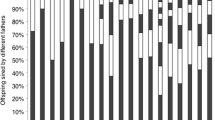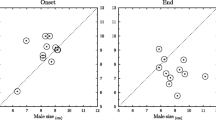Abstract
Environmental effects on the evolution of mating systems are increasingly discussed, but we lack many examples of how environmental conditions affect the expression and consequences of alternative mating systems. Variation in mate availability sets up a trade-off between reproductive assurance and inbreeding depression, but the consequences of both mate limitation and inbreeding may depend on other environmental conditions. Predation risk is common under natural conditions, and known to affect allocation to reproduction, but we know little about the effects of isolation and inbreeding under predation risk. We reared selfed and outcrossed hermaphroditic freshwater snails (Physa acuta) in four environments (predator cues present or absent crossed with mating partners available or not) and quantified life-history traits and cumulative lifetime fitness. Our results confirm that isolation from mates can increase longevity and growth, resulting in higher lifetime fecundity. Thus, we observed no evidence for mate limitation of reproduction. However, reproduction under isolation (i.e., selfing) resulted in inbreeding depression, which should counteract the benefits of selfing. Inbreeding depression in fitness occurred in both predator and no-predator environments, but there was no overall change in inbreeding depression with predator cues. This represents, to our knowledge, the first empirical estimate of the effect of predation risk on inbreeding depression in an animal. Cumulative fitness was most influenced by early survival and especially early fecundity. As predation risk and inbreeding (both ancestral and due to a lack of mates) reduced early fecundity, these effect are predicted to have important contributions to population growth under natural conditions. Therefore life-history plasticity (e.g., delayed reproduction) is likely to be very important to overall fitness.




Similar content being viewed by others
References
Armbruster P, Reed DH (2005) Inbreeding depression in benign and stressful environments. Heredity 95:235–242
Ashman T-L, Knight TM, Steets JA et al (2004) Pollen limitation of plant reproduction: ecological and evolutionary causes and consequences. Ecology 85:2408–2421
Auld JR, Relyea RA (2008) Are there interactive effects of mate availability and predation risk on life history and defense in a simultaneous hermaphrodite? J Evol Biol 21:1371–1378
Bijlsma R, Bundgaard J, van Putten WF (1999) Environmental dependence of inbreeding depression and purging in Drosophila melanogaster. J Evol Biol 12:1125–1137
Carr DE, Eubanks MD (2002) Inbreeding alters resistance to insect herbivory and host plant quality in Mimulus guttatus (Scrophulariaceae). Evolution 56:22–30
Caswell H (1989) Analysis of life table response experiments. I. Decomposition of effects on population growth rate. Ecol Model 46:221–237
Caswell H (2000) Prospective and retrospective perturbation analyses: their roles in conservation biology. Ecology 81:619–627
Caswell H (2001) Matrix population models: construction, analysis and interpretation, 2nd edn. Sinauer Associates, Inc, Sunderland, MA
Charlesworth D (2003) Effects of inbreeding on the genetic diversity of populations. Phil Trans R Soc Lond B 358:1051–1070
Charlesworth D, Charlesworth B (1987) Inbreeding depression and its evolutionary consequences. Ann Rev Ecol Syst 18:237–268
Charnov EL (1982) The theory of sex allocation. Princeton Univ Press, Princeton, NJ
Coutellec M-A, Lagadic L (2006) Effects of self-fertilization, environmental stress and exposure to xenobiotics on fitness-related traits of the freshwater snail Lymnaea stagnalis. Ecotoxicol 15:199–213
Crawley MJ (2005) Statistics: an introduction using R. Wiley, West Sussex, UK
Escobar JS, Epinat G, Sarda V, David P (2007) No correlation between inbreeding depression and delayed selfing in the freshwater snail Physa acuta. Evolution 61:2655–2670
Goodwillie C, Kalisz S, Eckert CG (2005) The evolutionary enigma of mixed mating in plants: occurrence, theoretical explanations, and empirical evidence. Ann Rev Ecol Evol Syst 36:47–79
Henry P-Y, Jarne P (2007) Marking hard-shelled gastropods: tag loss, impact on life-history traits, and perspectives in biology. Invert Biol 126:138–153
Henry P-Y, Pradel R, Jarne P (2003) Environment-dependent inbreeding depression in a hermaphroditic freshwater snail. J Evol Biol 16:1211–1222
Henry P-Y, Bousset L, Sourrouille P, Jarne P (2005) Partial selfing, ecological disturbance, and reproductive assurance in an invasive freshwater snail. Heredity 95:428–436
Ivey CT, Carr DE, Eubanks MD (2004) Effects of inbreeding in Mimulus guttatus on tolerance to herbivory in natural environments. Ecology 85:567–574
Jain SK (1976) The evolution of inbreeding in plants. Ann Rev Ecol Syst 7:469–495
Jarne P (1995) Mating system, bottlenecks and genetic polymorphism in hermaphroditic animals. Genet Res 65:193–207
Jarne P, Auld JR (2006) Animals mix it up too: the distribution of self-fertilization among hermaphroditic animals. Evolution 60:1816–1824
Jarne P, Finot L, Delay B, Thaler L (1991) Self-fertilization versus cross-fertilization in the hermaphroditic freshwater snail Bulinus globosus. Evolution 45:1136–1146
Jarne P, Perdieu M-A, Pernot A-F, Delay B, David P (2000) The influence of self-fertilization and grouping on fitness attributes in the freshwater snail Physa acuta: population and individual inbreeding depression. J Evol Biol 13:645–655
Johnston MO, Schoen DJ (1994) On the measurement of inbreeding depression. Evolution 48:1735–1741
Kalisz S, Vogler DW, Hanley KM (2004) Context-dependent autonomous self-fertilization yields reproductive assurance and mixed mating. Nature 430:884–887
Knight TM, Steets JA, Vamosi JC et al (2005) Pollen limitation of plant reproduction: pattern and process. Ann Rev Ecol Evol Syst 36:467–497
Knight TM, Steets JA, Ashman T-L (2006) A quantitative synthesis of pollen supplementation experiments highlights the contribution of resource reallocation to estimates of pollen limitation. Am J Bot 93:271–277
Lloyd DG (1979) Some reproductive factors affecting the selection of self-fertilization in plants. Am Nat 113:67–79
Ouborg NJ, Biere A, Mudde CL (2000) Inbreeding effects on resistance and transmission-related traits in the Silene-Microbotryum pathosystem. Ecology 81:520–531
Steets JA, Wolf DE, Auld JR, Ashman T-L (2007) The role of natural enemies in the expression and evolution of mixed mating in hermaphroditic plants and animals. Evolution 61:2043–2055
Stephenson AG, Leyshon B, Travers SE, Hayes CN, Windsor JA (2004) Interrelationships among inbreeding, herbivory, and disease on reproduction in a wild gourd. Ecology 85:3023–3034
R Development Core Team (2006) R: A language and environment for statistical computing. R Foundation for Statistical Computing, Vienna, Austria. ISBN 3-900051-07-0, URL http://www.R-project.org
Tsitrone A, Duperron S, David P (2003a) Delayed selfing as an optimal mating strategy in a preferentially outcrossing species: theoretical analysis of the optimal age at first reproduction in relation to mate availability. Am Nat 162:318–331
Tsitrone A, Jarne P, David P (2003b) Delayed selfing and resource reallocation in relation to mate availability in the freshwater snail Physa acuta. Am Nat 162:474–488
Verhoeven KJF, Simonsen KL, McIntyre LM (2005) Implementing false discovery rate control: increasing your power. Oikos 108:643–647
Waller DM, Dole J, Bersch AJ (2008) Effects of stress and phenotypic variation on inbreeding depression in Brassica rapa. Evolution 62:917–931
Wethington AR, Dillon RT (1991) Sperm storage and evidence for multiple insemination in a natural population of the freshwater snail, Physa. Am Malacol Bull 9:99–102
Acknowledgments
We received funding from the Malacological Society of London (JRA), Unitas Malacologica (JRA), and Pymatuning Laboratory of Ecology’s McKinley Research Grant (JRA), and the National Science Foundation (RAR). JRA was supported by fellowships from the A.W. Mellon Foundation and a post-doc from the French C.N.R.S. (awarded to P. David and A. Charmantier). We thank C. Cox, D. Jones, N. Schoeppner, and A. Stoler for help with the experiments. T.-L. Ashman, J. Escobar, M. Groner, P. Jarne, S. Kalisz, S. Tonsor, and several anonymous reviewers provided comments that improved this manuscript.
Author information
Authors and Affiliations
Corresponding author
Electronic supplementary material
Below is the link to the electronic supplementary material.
Rights and permissions
About this article
Cite this article
Auld, J.R., Relyea, R.A. Life-history plasticity and inbreeding depression under mate limitation and predation risk: cumulative lifetime fitness dissected with a life table response experiment. Evol Ecol 24, 1171–1185 (2010). https://doi.org/10.1007/s10682-010-9357-6
Received:
Accepted:
Published:
Issue Date:
DOI: https://doi.org/10.1007/s10682-010-9357-6




